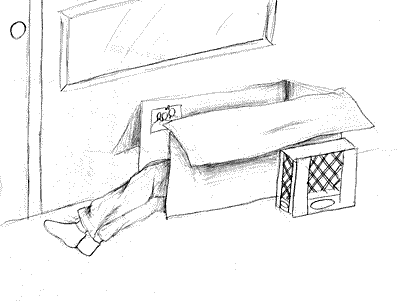All Nonfiction
- Bullying
- Books
- Academic
- Author Interviews
- Celebrity interviews
- College Articles
- College Essays
- Educator of the Year
- Heroes
- Interviews
- Memoir
- Personal Experience
- Sports
- Travel & Culture
All Opinions
- Bullying
- Current Events / Politics
- Discrimination
- Drugs / Alcohol / Smoking
- Entertainment / Celebrities
- Environment
- Love / Relationships
- Movies / Music / TV
- Pop Culture / Trends
- School / College
- Social Issues / Civics
- Spirituality / Religion
- Sports / Hobbies
All Hot Topics
- Bullying
- Community Service
- Environment
- Health
- Letters to the Editor
- Pride & Prejudice
- What Matters
- Back
Summer Guide
- Program Links
- Program Reviews
- Back
College Guide
- College Links
- College Reviews
- College Essays
- College Articles
- Back
The Young and the Homeless
Every day is dedicated to finding the next meal and making ends meet. They do whatever they can to get it, and if they can’t, they starve that day. Getting a job is not an option. Why? Because they aren’t old enough. When people think of homelessness, they usually don’t think of teenagers or children. However, in 2002 alone, there was an estimated 1,682,900 homeless and runaway youth in America ("Homeless Youth"). Although the number of homeless Americans is decreasing, the number of homeless youth is at an all-time high.
American children become homeless for many different reasons. The main reasons are family problems, economic problems, and residential instability. Oftentimes, young people leave their homes and become homeless because of abuse or harassment within their families. These problems often include physical and sexual harassment, parental neglect, or addiction of a family member. Teenagers are often pushed out of their own homes by their families and parents. Some youth also become homeless when their families cannot afford to support them anymore and encounter difficult financial issues. Another very common cause of youth homelessness is the transition from foster care and other public systems. When they grow too old to continue to be in the foster care system, teens are often released with little or no income support and thus, they end up on the streets.
The consequences of youth homelessness are very severe. Homeless young people often suffer from severe anxiety and depression, poor health and nutrition, and low self-esteem. They also have an increased chance of engaging in high-risk behaviors such as dealing drugs to meet their needs and engaging in unprotected sexual contact in exchange for food, clothing, or shelter. Studies have shown that the rate for HIV in homeless youth may be as much as two to ten times higher than the rates reported for other samples of adolescents in the United States (National Network for Youth, 1998). Additionally, homeless young people are so concerned with meeting their basic needs for survival that they have a hard time getting an education in order to support themselves financially in the future.
The issue of adolescent homelessness is still very prominent today. Some states, such as Illinois, New York, and Minnesota have introduced legislations to combat youth homelessness; however, there is a lot more than can be done. The government is so focused on trying to make certain aspects of homelessness illegal, like sleeping in public places, when they should be focusing on rescuing and preventing adolescents from becoming homeless. The first step the government can take is to help prevent homelessness in America’s youth. A system can be implemented to help families with financial problems, and prevent them from becoming homeless. For the children who are already on the streets, states can provide more living arrangements and counseling for these children to help regain stability. Although homelessness in America is decreasing, the number of young people on the streets is rising, and everyone needs to recognize that now in order to help save adolescents from this fate.
"Homeless Youth." National Coalition for the Homeless. National Coalition for the Homeless, June 2008. Web. 28 Oct. 2014.

Similar Articles
JOIN THE DISCUSSION
This article has 0 comments.
